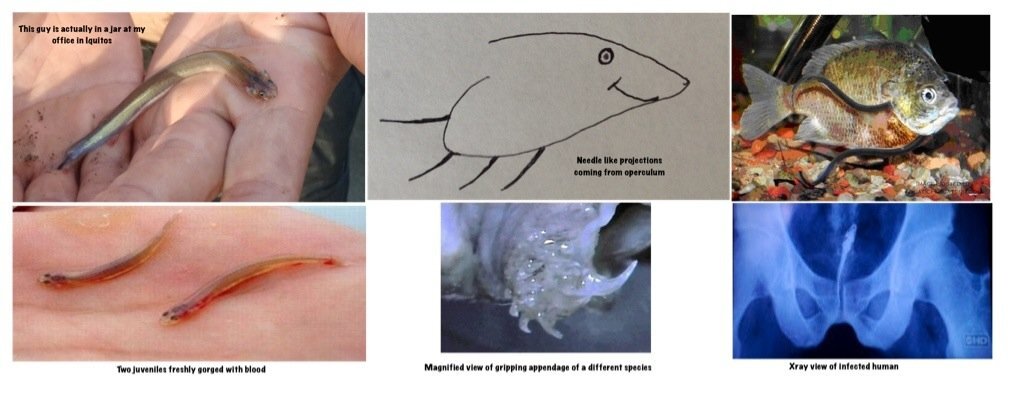The Candiru Penis Fish
Vandellia cirrhosa
Also know as:
Candiru, Cañero, Toothpick fish, Penis fish or Vampire fish.
Just reading through the names can make a grown man shiver and cringe.
There are a few things people should know about these creatures.
What they eat
How they find their food
Where they are found
How to avoid them
What to do if encountered
They are often the fist subject of conversations when new clients arrive to our lodge. People are extremely wary and naturally, no one wants an unexpected encounter with anything potentially dangerous. Read on a bit more to find out more!
What do they eat? How do they find it?
To understand the candiru, you need to know that it is hemophagous. Meaning they only feed on blood.
The candiru finds its victims through chemical and visual sensing.
The chemical sensing aspect is important because it opens the door for the possibility of attaching to the wrong host.
The candiru senses waste from the gas exchange performed by the gills. The waste is in the form of soluble urea secreted from the gills as a byproduct of respiration or absorbsion of 02.
The parasite will pierce the aortic arteries in the gills and gorge with blood in a matter of seconds. The high pressure produced from the pierced arteries floods the candiru , rendering any “blood sucking” talent moot. Similar to drinking from a firehose.
Urea is a common waste product secreted by most living things either through sweat or urine including humans. This is why it is common to hear our guides say:
Please, do not pee in the water!!!
This type of fish is very common in all water types of South America. Their main hosts, (big fish) are plentiful and present many opportunities to feed and prosper.
Any feeding opportunity is a one-way trip for the parasite due to its head being uniquely equipped with reverse spines on its operculum. The spines prevent slippage and help by fastening itself to the host. Once gorged, they swim out of the mouth of their host without trouble.
That is why, any candiru that attempts to parasitize a human, is a dead candiru. There is no way for it to slide backwards and out of a tight orifice.
Reverse opercular spines
This is not Vandellia sp but the spiny, gripping structure is very similar
Is the Candiru potentially dangerous?
The short answer is yes, but the chances of this happening are very slim and several things would have to line up for this opportunity to prevail.
First, the candiru cannot swim UP a stream of urine.
An individual would have to have his/her groin section in the water at the time of attack.
Are you planning on skinny dipping?
Why?????? are you #@$*&^% crazy?
There are piranhas as well buddy, there are better ways to get a late circumcision.
Better and more sanitary ways.
Reminder that we use worms for fish bait.
Extra measure for care:
Wear tight underpants and you have nothing to fear!
Has there ever been a case of candiru affecting humans? if so what is the remedy?
Yes, there has been several cases of candiru attempting to parasitize a human. In one case, from Iquitos 2017 the candiru swam up an anus of a young bather. The child was given an anesthetic enema and as the fishes spines relaxed, the enema was able to flush the fish out without surgery.
Another case in Brazil, a candiru had to be surgically removed from a mans urethra, most likely the only viable remedy.
Old folk tales from the Amazon say that if a candiru is in your urethra.
The remedy is to roll up citrus leaves and insert them in the urethra until it connects with the fish.
Than weeks later you die of an infection. Because that was stupid and you should have gone to a hospital.
While anecdotal remedies are interesting, often amusing, they are most likely ineffective and can cause more harm than good.
To end on a positive note, after 18 years, we haven’t had any incidences with these fish that we didnt ask for.
Often when netting fish on the river, we capture many different species of this parasite, never once have we had one try to “get in”.
There is enough to worry about on your trip, rest assured that our guides will escort you though the most biodiverse ecosystem on the planet and return you unharmed, unscathed and with a new look on life!




